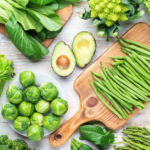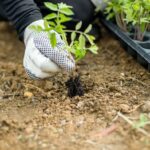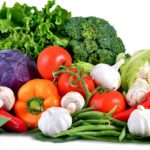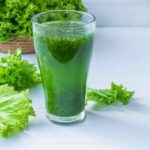Vegetable when to plant Are you looking to start a vegetable garden but aren’t sure when to plant? Timing is everything when it comes to gardening, and planting vegetables at the right time can make all the difference in your harvest. Our latest blog post provides a general guide to when common vegetables should be planted, based on climate and growing conditions
Vegetables when to plant – Points To Consider

If you’re thinking of starting a vegetable garden, it’s important to consider the timing of when to plant. Planting too early or too late can affect the growth and quality of your produce. Here are some key points to consider when determining when to plant vegetables:
Climate Zone: Your climate zone is important when determining when to plant. Each plant has a preferred temperature range for growth, and different regions have different temperature patterns. Be sure to research the ideal planting times for your specific climate zone.
Climate Zone:
Your climate zone is important when determining when to plant. Each plant has a preferred temperature range for growth, and different regions have different temperature patterns. Be sure to research the ideal planting times for your specific climate zone.
Soil Temperature:
is critical to the success of planting vegetables. Most vegetables prefer warm soil, so waiting until the soil has warmed up sufficiently before planting is important. Before planting, check the temperature of the soil with a thermometer.
Frost Dates:
The last frost date in the spring and the first frost date in the fall are important to consider when planting vegetables. Planting too early can result in frost damage while planting too late can limit the growing season.
Days to Maturity:
The days to maturity, or the amount of time it takes for a plant to reach maturity, is an important factor to consider when determining when to plant. Be sure to plan ahead and give your vegetables enough time to mature before the end of the growing season.
Succession Planting:
Succession planting involves planting multiple crops throughout the growing season to ensure a continuous harvest. This strategy can be especially effective for crops like lettuce, which have a shorter growing season
Garden Planning Tool
Vegetable when to plant

A garden planning tool is an essential resource for anyone looking to start or maintain a garden. There are many different types of garden planning tools available, ranging from basic paper and pencil designs to more advanced software programs.
Customizable Layouts:
A good garden planning tool should allow you to create a customized layout for your garden. This may include features like raised beds, trellises, or pathways.
Plant Selection:
Some garden planning tools will include a database of plants, with information on their specific growing requirements. Right plants for your garden, based on factors like sunlight, soil type, and water needs.
Seasonal Planning:
A garden planning tool should allow you to plan for different growing seasons, including spring, summer, and fall. Tool that allows you to easily switch between different seasons and adjust your planting schedule
Budgeting:
Some garden planning tools will allow you to create a budget for your garden, including the cost of seeds, soil, and other supplies. You can stay on track and limit your expenditure by doing this.
Mobile Compatibility:
If you want to be able to access your garden plans on the go, look for a tool that is compatible with mobile devices.
There are many different garden planning tools available, ranging from simple free online planners to more advanced paid software programs. Consider your specific needs and budget when choosing a tool, and be sure to read reviews and user feedback before making a final decision.
Soil Preparation
Vegetable when to plant

Clear the Area:
Begin by clearing the area where you want to plant. Remove any weeds, rocks, or debris from the soil ensure that your plants have plenty of space to grow and won’t have to compete for nutrients.
Test the Soil:
It’s a good idea to test the soil before planting, in order to determine its pH level and nutrient content. You can purchase a soil testing kit at a garden center or send a soil sample to a testing laboratory.
Amend the Soil:
Based on the results of your soil test, you need to amend the soil in order to provide the necessary nutrients for your plants. Soil amendments include compost, aged manure, and organic fertilizers.
Till the Soil:
Tilling the soil can help break up any compacted soil and make it easier for plant roots to penetrate. Use a garden tiller to work the soil to a depth of 8 to 10 inches.
Level the Soil:
After tilling, level the soil with a rake to provide a smooth planting surface.
Mulch the Soil:
Finally, consider adding a layer of mulch to the soil surface. Mulch can help retain moisture, prevent weeds, and regulate soil temperature.
By following these steps, you can create a healthy and nutrient-rich soil environment that will support the growth and productivity of your vegetable garden.
Vegetable when to plant month by month
January
January is a great time to start planning your garden for the upcoming growing season. Here are some things you can do in January to prepare for your garden:
- Radishes: Radishes are a quick-growing vegetable that can be planted in January and harvested in as little as 30 days.
- Lettuce: Lettuce can be grown indoors or in a greenhouse in January. Choose a variety that is appropriate for cooler climates.
February
February marks the beginning of the gardening season for many gardeners. Here are some things you can do in February to prepare for your garden:
- Potatoes: Plant seed potatoes in February for a harvest in late spring or early summer. Choose a variety that is appropriate for your climate.
- Carrots: Carrots can be planted in March in most climates. Choose a variety that is suited to your area and soil type.
March
March is a busy time in the garden, as it marks the beginning of the planting season for many vegetables. Here are some things you can do in March to prepare for your garden:
- Peas: Peas can be planted in March in most climates. Choose a variety that is suited to your area, such as sugar snap or snow peas.
- Spinach: Spinach is a hardy vegetable that can be planted in March in most climates. It can tolerate cooler temperatures and will mature quickly.
April
April is an exciting time in the garden as the weather continues to warm up and more vegetables can be planted. Here are some things you can do in April to prepare for your garden:
- Tomatoes: Tomatoes can be planted in April in most climates. Choose a variety that is suited to your area and soil type.
- Peppers: Peppers can be planted in April in most climates. They prefer warm soil and full sun, so make sure to choose a sunny location.
May
May is a busy month in the garden as many vegetables start to grow quickly and require frequent maintenance. Here are some things you can do in May to prepare for your garden:
- Corn: Corn can be planted in May in most climates. It requires full sun and regular watering, and it can be a heavy feeder, so make sure to fertilize.
- Eggplant: Eggplant can be planted in May in most climates. It prefers warm soil and full sun, and it can be a heavy feeder, so make sure to fertilize.
June
June is a great month in the garden as many vegetables start to produce fruit and you can enjoy the fruits of your labor. Here are some things you can do in June to prepare for your garden:
- Cucumbers: Cucumbers can still be planted in June in most climates. Make sure to choose a variety that is suited to your area and soil type.
- Squash: Squash can still be planted in June in most climates. Choose a variety that is suited to your area and soil type.
July
July is a hot month in the garden, and plants are growing fast. Here are some things you can do in July to keep your garden healthy and productive:
- Beans: Beans can still be planted in July in most climates. Choose a variety that is suited to your area and soil type, and make sure to provide support for climbing varieties.
- Melons: Melons can still be planted in July in warmer climates. They prefer warm soil and full sun, and they can be a heavy feeder, so make sure to fertilize.
August
August is a month of both bounty and preparation in the garden. Here are some things you can do in August to prepare for the fall growing season:
- Beets: Beets can be planted in August in most climates. Choose a fast-maturing variety to ensure a good harvest before the first frost.
- Broccoli: Broccoli can be planted in August in cooler climates. Choose a fast-maturing variety to ensure a good harvest before the first frost.
September
September marks the beginning of the fall season and is a busy month in the garden as you prepare for the cooler weather. Here are some things you can do in September to keep your garden healthy and productive:
- Cabbage: Cabbage can be planted in September in cooler climates. Choose a fast-maturing variety to ensure a good harvest before the first frost.
- Cauliflower: Cauliflower can be planted in September in cooler climates. Choose a fast-maturing variety to ensure a good harvest before the first frost.
October
October is an important month in the garden as you prepare for the cooler weather and start to wind down your growing season. Here are some things you can do in October to keep your garden healthy and prepare for the winter:
- Garlic: Garlic can be planted in October in most climates. Plant cloves about 2 inches deep and 6 inches apart in well-drained soil.
- Onions: Onions can be planted in October in most climates. Plant onion sets or seedlings about 1 inch deep and 4-6 inches apart in well-drained soil.
November
November is a month of preparation and cleanup in the garden as you prepare for the winter season. Here are some things you can do in November to keep your garden healthy and ready for the next growing season:
Kale: Kale can be planted in October in cooler climates. It is a hardy vegetable that can tolerate frost, so it is a great choice for a fall crop.
Brussels Sprouts: Brussels sprouts can be planted in September in cooler climates. They are a slow-growing vegetable, so choose a variety that will mature in time for the first frost.
December
December is typically a quieter month in the garden as the colder weather sets in, but there are still some things you can do to prepare for the next growing season:
- Microgreens: Microgreens are a great choice for indoor gardening in December. They are easy to grow and can be harvested in as little as 2 weeks. Try growing microgreens like radish, broccoli, or mustard greens.
- Herbs: Many herbs, such as basil, cilantro, parsley, and chives, can be grown indoors in pots or on a sunny windowsill. They make a great addition to your winter meals and can be harvested year-round.
- Salad greens: Salad greens like lettuce, spinach, and arugula can be grown indoors or in a greenhouse. Choose a fast-growing variety to ensure a good harvest before the winter months are over.













5 thoughts on “Vegetable when to plant? Ultimate best guide”